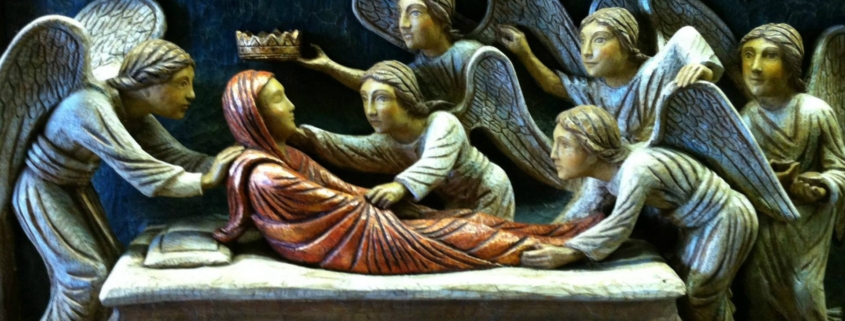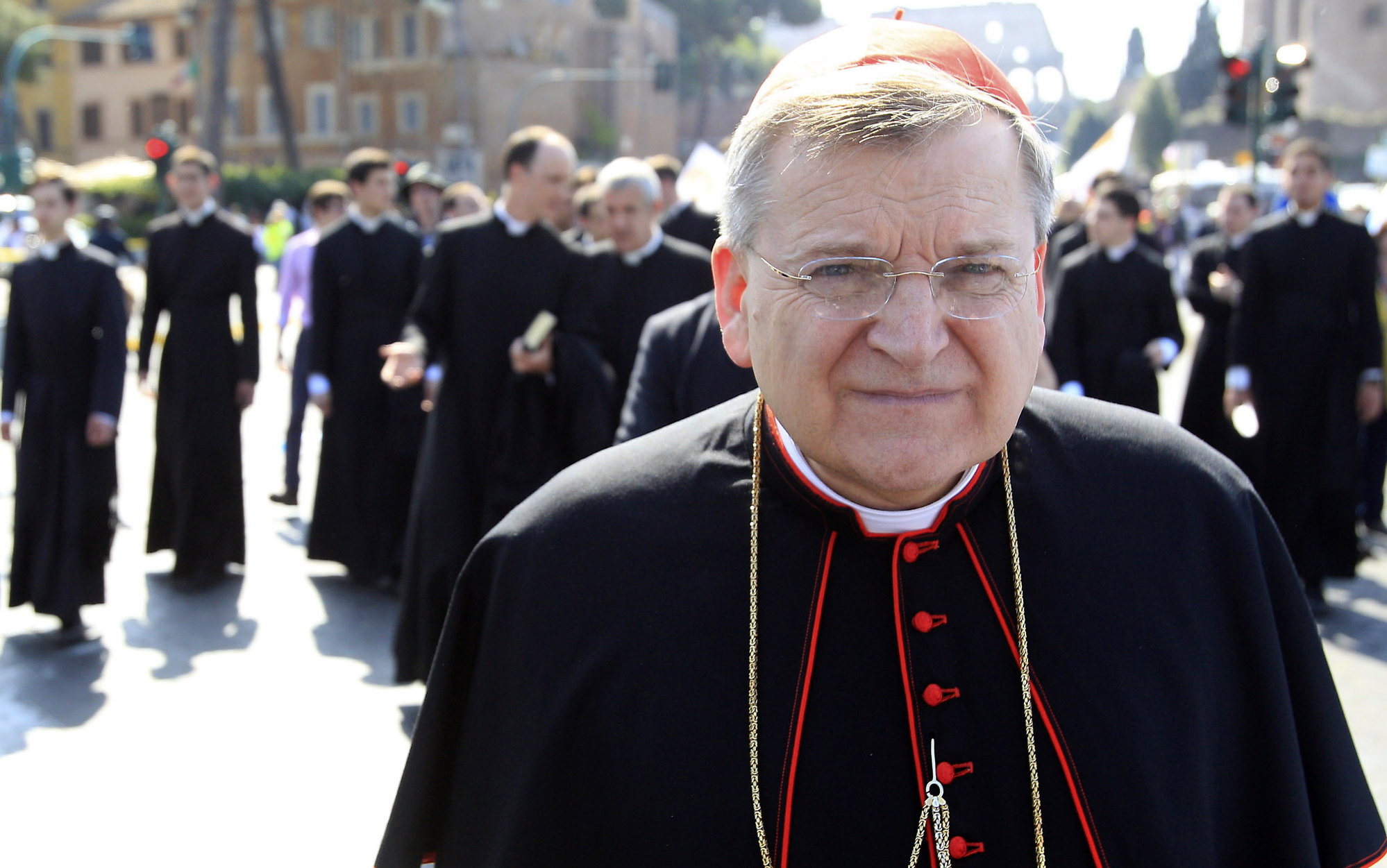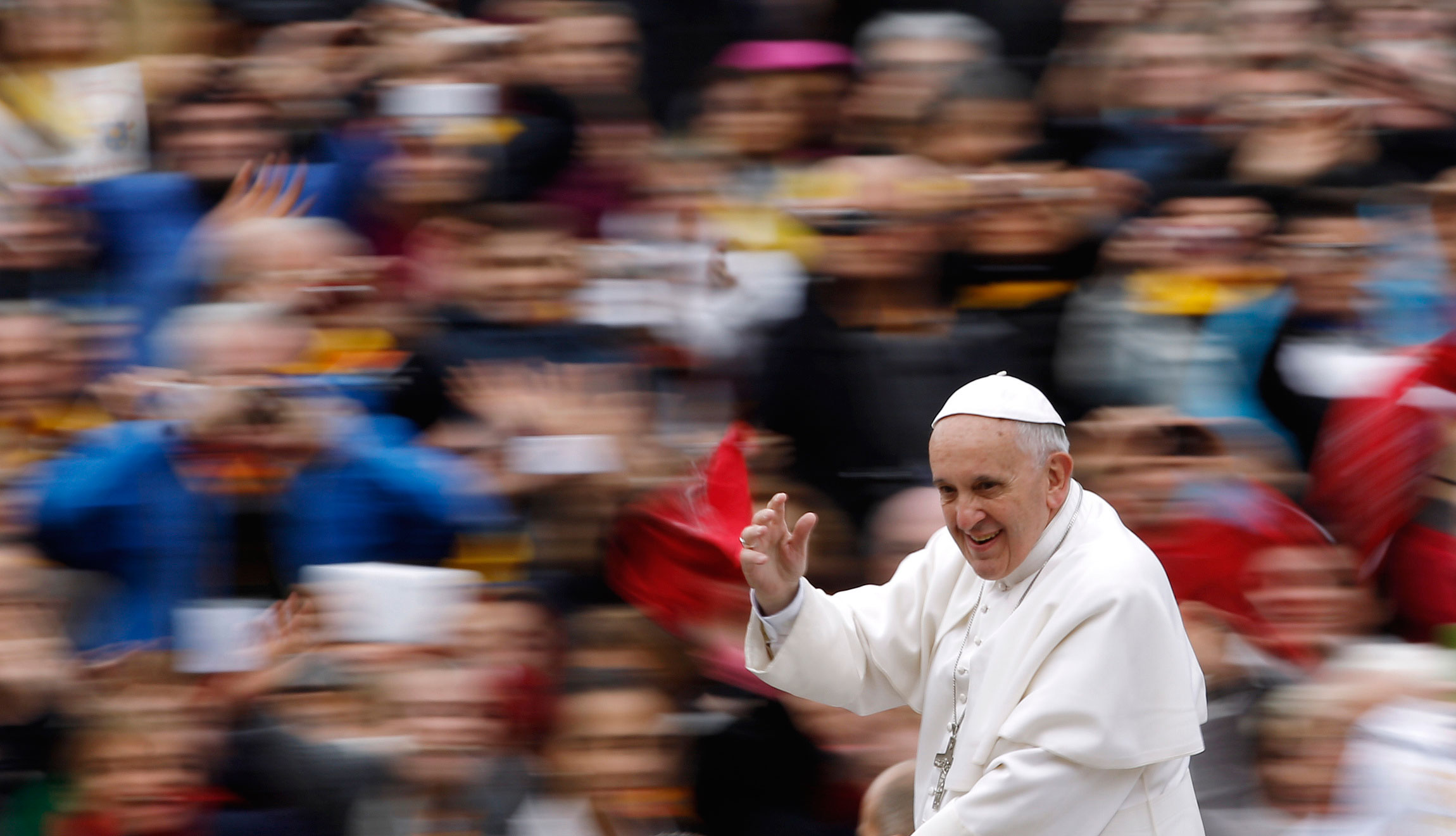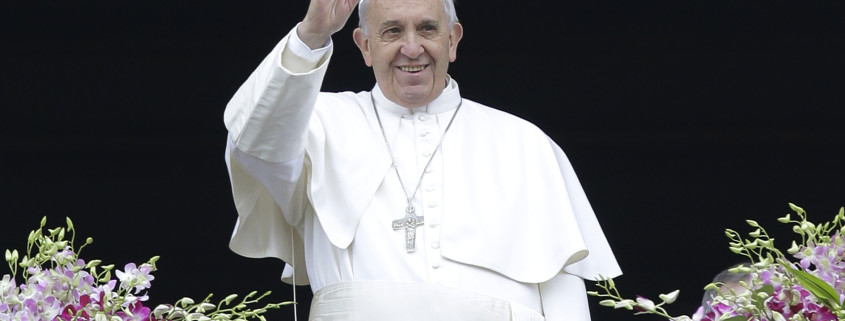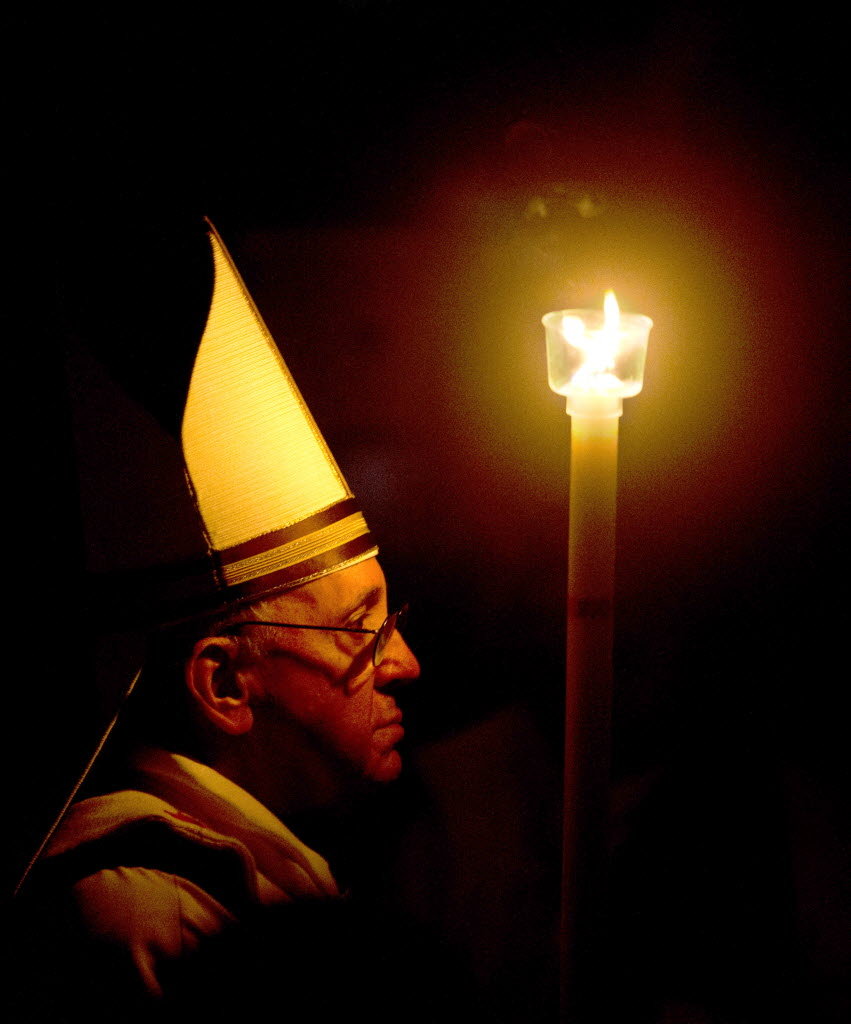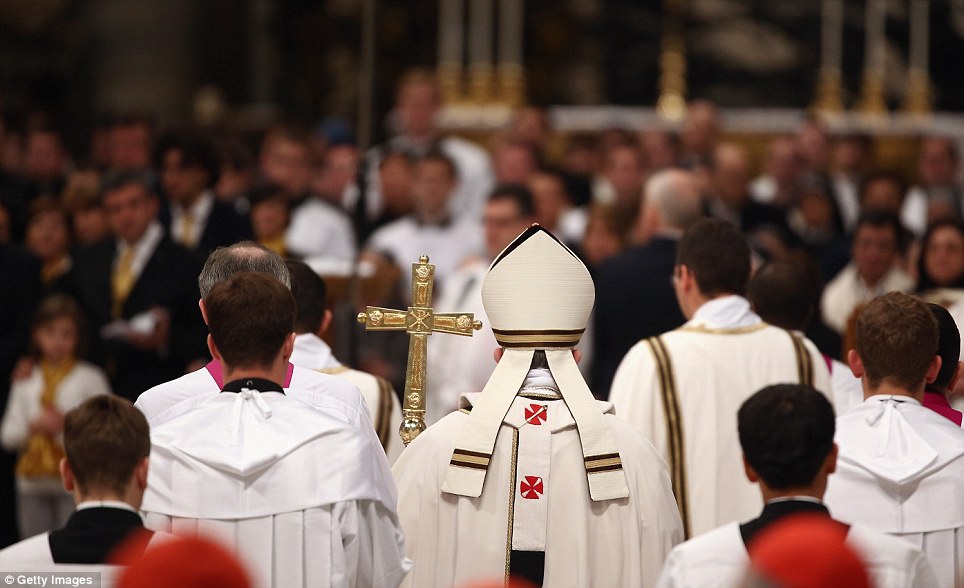Note: this is the homily of Fr. Raniero Cantalamessa, OFM, Cap., Preacher of the Papal Household, which was just delivered at the Good Friday Serivice for the Passion of the Lord in St. Peter’s Basilica in Rome.
We have just heard the account of Jesus’ trial before Pilate. There is one point in particular in that account on which we need to pause.
“Then Pilate took Jesus and scourged him. And the soldiers plaited a crown of thorns, and put it on his head, and clothed him in a purple robe; they came up to him, saying, ‘Hail King of the Jews!’ and struck him with their hands. . . . So Jesus came out, wearing the crown of thorns and the purple robe. Pilate said to them, ‘Here is the man!’ [Ecce Homo!] (Jn 19:1-3, 5)
Among the innumerable paintings that have the Ecce Homo as their subject, there is one that has always impressed me. It is by the sixteenth-century Flemish painter, Jan Mostaert. Let me try to describe it. It will help imprint the episode better in our minds, since the artist only transcribes faithfully in paint the facts of the gospel account, especially that of Mark (see Mk 15:16-20).
Jesus has a crown of thorns on his head. A sheaf of thorny branches found in the courtyard, perhaps to light a fire, furnished the soldiers an opportunity for this parody of his royalty. Drops of blood run down his face. His mouth is half open, like someone who is having trouble breathing. On his shoulders there is heavy and worn-out mantle, more similar to tinplate than to cloth. His shoulders have cuts from recent blows during his flogging. His wrists are bound together by a coarse rope looped around twice. They have put a reed in one of his hands as a kind of scepter and a bundle of branches in the other, symbols mocking his royalty. Jesus cannot move even a finger; this is a man reduced to total powerlessness, the prototype of all the people in history with their hands bound.
Meditating on the passion, the philosopher Blaise Pascal wrote these words one day: “Christ will be in agony until the end of the world; we must not sleep during this time.” There is a sense in which these words apply to the person of Christ himself, that is, to the head of the mystical body, and not just to its members. Not despite being risen and alive now but precisely because he is risen and alive. But let us leave aside this meaning that is too enigmatic and talk instead about the most obvious meaning of these words. Jesus is in agony until the end of the world in every man or woman who is subjected to his same torments. “You did it to me!” (Matt 25:40). He said these words not only about believers in him; he also said it about every man or woman who is hungry, naked, mistreated, or incarcerated.
For once let us not think about social evils collectively: hunger, poverty, injustice, the exploitation of the weak. These evils are spoken about often (even if it is never enough), but there is the risk that they become abstractions—categories rather than persons. Let us think instead of the suffering of individuals, people with names and specific identities; of the tortures that are decided upon in cold blood and voluntarily inflicted at this very moment by human beings on other human beings, even on babies.
How many instances of “Ecce homo” (“Behold the man!”) there are in the world! How many prisoners who find themselves in the same situation as Jesus in Pilate’s praetorium: alone, hand-cuffed, tortured, at the mercy of rough soldiers full of hate who engage in every kind of physical and psychological cruelty and who enjoy watching people suffer. “We must not sleep; we must not leave them alone!”
The exclamation “Ecce homo!” applies not only to victims but also to the torturers. It means, “Behold what man is capable of!” With fear and trembling, let us also say, “Behold what we human beings are capable of!” How far we are from the unstoppable march forward, from the homo sapiens sapiens (the enlightened modern human being), from the kind of man who, according to someone, was to be born from the death of God and replace him!
* * *
Christians are of course not the only victims of homicidal violence in the world, but we cannot ignore the fact that in many countries they are the most frequently intended victims. Jesus said to his disciples one day, “The hour is coming when whoever kills you will think he is offering service to God” (Jn 16:2). Perhaps never before have these words found such precise fulfillment as they do today.
A third-century bishop, Dionysius of Alexandria, has left us a testimony of an Easter celebrated by Christians during the fierce persecutions by the Roman emperor Decius:
First we were set on and surrounded by persecutors and murderers, yet we were the only ones to keep festival even then. Every spot where we were attacked became for us a place for celebrations whether field, desert, ship, inn, or prison. The most brilliant festival of all was kept by the fulfilled martyrs, who were feasted in heaven.
This is the way Easter will be for many Christians this year, 2015 after Christ.
There was someone who, in the secular press, had the courage to denounce the disturbing indifference of world institutions and public opinion in the face of all this killing of Christians, recalling what such indifference has sometimes brought about in the past. All of us and all our institutions in the West risk being Pilates who wash our hands.
However, we are not allowed to make any denunciations today. We would be betraying the mystery we are celebrating. Jesus died, crying out, “Father, forgive them; for they know not what they do” (Lk 23:34). This prayer was not simply murmured under his breath; it was cried out so that people could hear it well. Neither is it even a prayer; it is a peremptory request made with the authority that comes from being the Son: ”Father, forgive them!” And since he himself had said that the Father heard all his prayers (see Jn 11:42), we have to believe that he heard this last prayer from the cross and consequently that the crucifiers of Christ were then forgiven by God (not of course without in some way being repentant) and are with him in paradise, to testify for all eternity to what extremes the love of God is capable of going.
Ignorance, per se, existed exclusively among the soldiers. But Jesus’ prayer is not limited to them. The divine grandeur of his forgiveness consists in the fact that it was also offered to his most relentless enemies. The excuse of ignorance is brought forward precisely for them. Even though they acted with cunning and malice, in reality they did not know what they were doing; they did not think they were nailing to the cross a man who was actually the Messiah and the Son of God! Instead of accusing his adversaries, or of forgiving them and entrusting the task of vengeance to his heavenly Father, he defended them.
He presents his disciples with an example of infinite generosity. To forgive with his same greatness of soul does not entail just a negative attitude through which one renounces wishing evil on those who do evil; it has to be transformed instead into a positive will to do good to them, even if it is only by means of a prayer to God on their behalf. “Pray for those who persecute you” (Matt 5:44). This kind of forgiveness cannot seek recompense in the hope of divine punishment. It must be inspired by a charity that excuses one’s neighbor without, however, closing one’s eyes to the truth but, on the contrary, seeing to stop evildoers in such a way that they will do no more harm to others and to themselves.
We might want to say, “Lord, you are asking us to do the impossible!” He would answer, “I know, but I died to give you what I am asking of you. I not only gave you the command to forgive and not only an heroic example of forgiveness, but through my death I also obtained for you the grace that enables you to forgive. I did not give the world just a teaching on mercy as so many others have. I am also God and I have poured out for you rivers of mercy through my death. From them you can draw as much mercy as you want during the coming jubilee year of Mercy.”
***
Someone could say, “So then, does following Christ always mean surrendering oneself passively to defeat and to death?” On the contrary! He says to his disciples, “Be of good cheer” before entering into his passion: “I have overcome the world” (Jn 16:33). Christ has overcome the world by overcoming the evil of the world. The definitive victory of good over evil that will be manifested at the end of time has already come to pass, legally and de facto, on the cross of Christ. “Now,” he said, “is the judgment of this world” (Jn 12:31). From that day forth, evil is losing, and it is losing that much more when it seems to be triumphing more. It has already been judged and condemned in its ultimate expression with a sentence that cannot be appealed.
Jesus overcame violence not by opposing it with a greater violence but by enduring it and exposing all its injustice and futility. He inaugurated a new kind of victory that St. Augustine summed up in three words: “Victor quia victima: “Victor because victim.” It was seeing him die this way that caused the Roman centurion to exclaim, “Truly this man was the Son of God!” (Mk 15:39). Others asked themselves what the “loud cry” emitted by the dying Jesus could mean (see Mk 15:37). The centurion, who was an expert in combatants and battles, recognized at once that it was a cry of victory.
The problem of violence disturbs us, shocks us, and it has invented new and horrendous forms of cruelty and barbarism today. We Christians are horrified at the idea that people can kill in God’s name. Someone, however, could object, “But isn’t the Bible also full of stories of violence? Isn’t God called ‘the Lord of hosts’? Isn’t the order to condemn whole cities to extermination attributed to him? Isn’t he the one who prescribes numerous cases for the death penalty in the Mosaic Law?”
If they had addressed those same objections to Jesus during his life, he would surely have responded with what he said regarding divorce: “For your hardness of heart Moses allowed you to divorce your wives, but from the beginning it was not so” (Mt 19:8). The same is true for violence: “at the beginning it was not so.” The first chapter of Genesis presents a world where violence is not even thinkable, neither among human beings themselves nor between people and animals. Not even to avenge the death of Abel, and therefore punish a murderer, is it permissible to kill (see Gen 4:15).
God’s true intention is expressed by the commandment “You shall not kill” more than by the exceptions to that command in the law, which are concessions to the “hardness of heart” and to people’s practices. Violence, along with sin, is unfortunately part of life, and the Old Testament, which reflects life and must be useful for life as it is, seeks through its legislation and the penalty of death at least to channel and curb violence so that it does not degenerate into personal discretion and people then tear each other apart.
Paul speaks about a period of time that is characterized by the “forbearance” of God (see Rom 3:25). God forbears violence the way he forbears polygamy, divorce, and other things, but he is preparing people for a time in which his original plan will be “recapitulated” and restored in honor, as though through a new creation. That time arrived with Jesus, who proclaims on the mount, “You have heard that it was said, ‘An eye for an eye and a tooth for a tooth.’ But I say to you, Do not resist one who is evil. But if anyone strikes you on the right check, turn to him the other also. . . . You have heard that it was said, ‘You shall love your neighbor and hate your enemy.’ But I say to you, Love your enemies and pray for those who persecute you” (Matt 5:38-39, 43-44).
The true “Sermon on the Mount” that changed history is not, however, the one spoken on a hill in Galilee but the one now proclaimed, silently, from the cross. On Calvary Christ delivers a definitive “no” to violence, setting in opposition to it not just non-violence but, even more, forgiveness, meekness, and love. Although violence will still continue to exist, it will no longer—not even remotely—be able to link itself to God and cloak itself in his authority. To do so would make the concept of God regress to primitive and crude stages in history that have been surpassed by the religious and civilized conscience of humanity.
True martyrs for Christ do not die with clenched fists but with their hands joined in prayer. We have had many recent examples of this. Christ is the one who gave the twenty-one Coptic Christians beheaded in Libya by ISIS this past February 22 the strength to die whispering the name of Jesus.
Lord Jesus Christ, we pray for our persecuted brothers and sisters in the faith and for all the Ecce Homo human beings who are on the face of the earth at this moment, Christian and non-Christian. Mary, at the foot of the cross you united yourself to your Son, and you whispered, after him, “Father, forgive them!” Help us overcome evil with good, not only on the world scene but also in our daily lives, within the walls of our homes. You “shared his sufferings as he died on the cross. Thus, in a very special way you cooperated by your obedience, faith, hope and burning charity in the work of the Savior.” May you inspire the men and women of our time with thoughts of peace and mercy. And of forgiveness. Amen.


